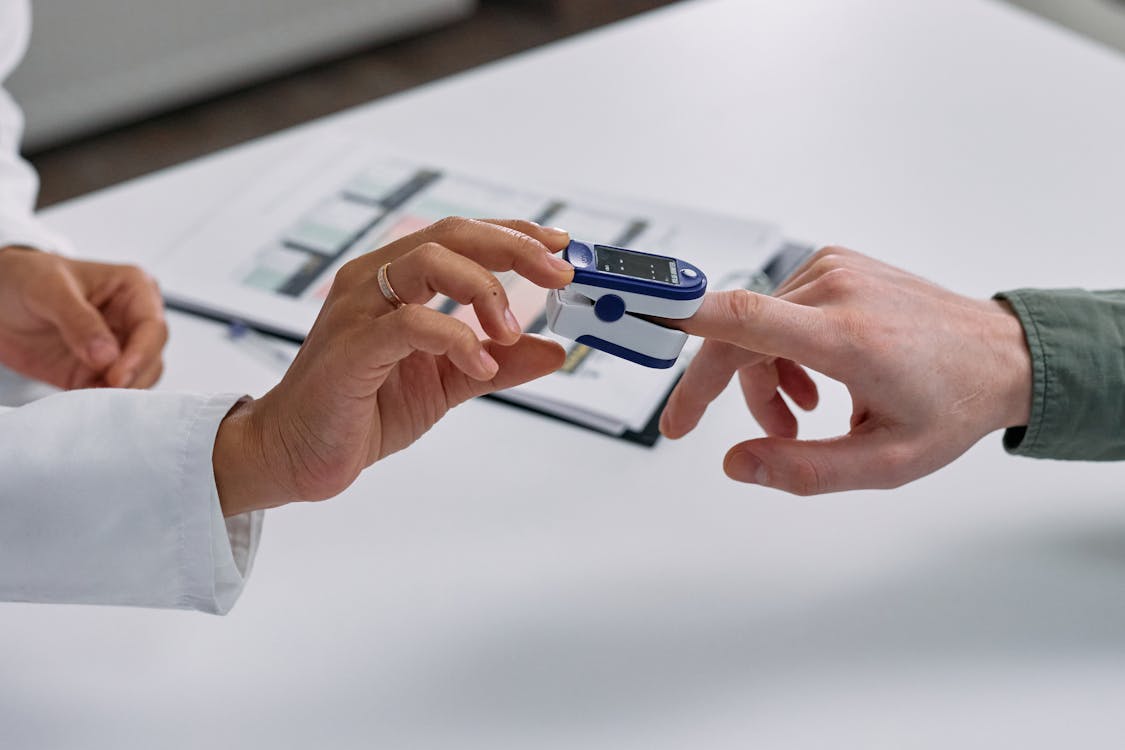

Pulse oximetry exercise tests measure how well your body uses oxygen during physical activity. These simple, non-invasive tests can reveal important information about your heart and lung health.
The test involves wearing a small device on your finger or earlobe while you walk or pedal a stationary bike. This device tracks your blood oxygen levels and heart rate as you exercise.
Doctors often use pulse oximetry exercise tests to check for lung problems or heart issues. The results help them see how your body responds to increased activity. This can guide treatment plans and show if current therapies are working well.
Pulse oximetry is a vital medical technique for measuring blood oxygen levels. It uses light to quickly and painlessly assess a person's oxygen saturation.
Pulse oximetry works by shining red and infrared light through a thin body part, like a fingertip or earlobe. Blood absorbs different amounts of light depending on how much oxygen it carries.
Oxygenated blood absorbs more infrared light and lets more red light pass through. Deoxygenated blood does the opposite.
The device measures these light differences to calculate oxygen levels.
The "pulse" in pulse oximetry comes from detecting small changes in light absorption with each heartbeat. This helps separate the arterial blood signal from other tissues.
A typical pulse oximeter has these key parts:
Most devices clip onto a finger or earlobe. The LEDs shine light from one side, while the detector on the other side measures how much passes through.
Some models work on the forehead or wrist. These may use reflected light instead of transmitted light to get readings.
Oxygen saturation (SpO2) shows the percentage of oxygen-carrying hemoglobin in the blood. Normal levels are usually 95% to 100%.
The oximeter calculates SpO2 by comparing the absorption of red and infrared light. It uses complex algorithms to account for individual differences and other factors.
Besides oxygen levels, pulse oximeters also measure heart rate. They count the number of light pulses detected per minute.
To get accurate results, the sensor must fit well without being too tight. Movement, nail polish, and poor circulation can affect readings.
Pulse oximetry exercise testing measures blood oxygen levels during physical activity. This test helps doctors check how well the lungs and heart work together when the body needs more oxygen.
The test uses a small device called a pulse oximeter. It clips onto a finger or earlobe and shines light through the skin to measure oxygen in the blood.
Patients exercise on a treadmill or stationary bike. The test starts slow and gets harder. It lasts about 6 to 12 minutes. Doctors watch oxygen levels the whole time.
Patients also wear a heart rate monitor. This tracks how fast the heart beats during exercise.
Before starting, the doctor explains the test and answers questions. Patients change into comfortable clothes and shoes.
The pulse oximeter goes on a finger or earlobe. Patients warm up for a few minutes, then they start exercising at an easy pace.
Every few minutes, the exercise gets harder. Patients keep going until they're tired or their oxygen levels drop too low.
Doctors watch closely and can stop the test at any time if needed. After finishing, patients cool down and rest.
Normal results show oxygen levels staying above 90% during exercise. A drop below 88% may mean lung or heart problems.
Doctors look at how fast and how much oxygen levels change. They also check heart rate and breathing.
Low oxygen with a normal heart rate could mean lung disease. High heart rate with low oxygen might point to heart issues.
The test helps find problems that don't show up when resting. It can guide treatment plans and track how well treatments work over time.
Pulse oximetry exercise tests have important uses in healthcare. They help doctors check heart and lung function and see if treatments are working.
Pulse oximetry exercise tests measure oxygen levels during physical activity. This shows how well the heart and lungs work together.
Doctors use these tests to find problems with:
The test results help diagnose conditions like:
Patients walk on a treadmill or ride a stationary bike during the test. A device on their finger tracks oxygen saturation. Doctors watch for any drops in oxygen levels as exercise intensity increases.
These tests also help track how well treatments are working. Doctors use them to:
Patients take the test before and after treatment. This shows if their oxygen levels have improved. Better oxygen levels mean the treatment is working.
The tests are useful for many conditions:
Regular testing helps doctors adjust treatments as needed. This leads to better outcomes for patients with heart and lung problems.
Pulse oximetry exercise tests have some important factors to keep in mind. These include accuracy issues and patient-specific elements that can affect results.
Pulse oximeters may give inaccurate readings during exercise. Movement can cause the sensor to slip, leading to false measurements. Sweat can also interfere with the device's function.
Some oximeters struggle to detect low oxygen levels. This is a big problem for exercise tests aiming to spot breathing issues.
Cheap or poorly made devices often give wrong results. It's crucial to use high-quality, well-maintained equipment for trustworthy data.
Bright lights in the test area can throw off readings. Testers should set up in a place with controlled lighting for best results.
Not all people are good candidates for this test. Those with very low blood flow in their fingers may get faulty readings.
Skin tone can affect accuracy. Dark skin pigment sometimes causes oximeters to overestimate oxygen levels.
Nail polish and artificial nails can block the sensor's light. Patients should remove these before testing.
Some health conditions like anemia change how oximeters work. Doctors need to know a patient's full health history for proper test interpretation.
Anxiety during the test can alter breathing patterns. This may lead to results that don't show true exercise capacity.